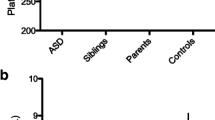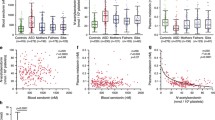Abstract
Elevated whole blood serotonin (WB5-HT) is a well-replicated biomarker in autism spectrum disorder (ASD). Decreased platelet serotonin receptor 5-HT2A binding has been reported in ASD. WB5-HT levels and platelet 5-HT2A specific binding were obtained from 110 individuals with ASD and 18 controls. Individuals with ASD had significantly higher WB5-HT levels than controls. There was no difference in the platelet 5-HT2A specific binding between groups. Multiple regression analyses revealed that platelet 5-HT2A binding significantly predicted WB5-HT in the control sample but not in the ASD sample. These results indicate that the relationship between WB5-HT and platelet 5-HT2A binding differs depending on ASD diagnosis, suggesting differences in platelet 5-HT system regulation in ASD.

Similar content being viewed by others
References
American Psychiatric Association. (2000). Diagnostic and statistical manual of mental disorders (4th ed., text rev.). Washington, DC: Author.
Amodeo, D. A., Rivera, E., Dunn, J. T., & Ragozzino, M. E. (2016). M100907 attenuates elevated grooming behavior in the BTBR mouse. Behavioural Brain Research, 313, 67–70. https://doi.org/10.1016/j.bbr.2016.06.064.
Anderson, G. M., Feibel, F. C., & Cohen, D. J. (1987). Determination of serotonin in whole blood, platelet-rich plasma, platelet-poor plasma and plasma ultrafiltrate. Life Sciences, 40(11), 1063–1070.
Anderson, G. M., Horne, W. C., Chatterjee, D., & Cohen, D. J. (1990). The Hyperserotonemia of Autisma. Annals of the New York Academy of Sciences, 600(1), 331–340.
Chen, R., Davis, L. K., Guter, S., Wei, Q., Jacob, S., Potter, M. H., et al. (2017). Leveraging blood serotonin as an endophenotype to identify de novo and rare variants involved in autism. Molecular Autism, 8(1), 1–12.
Cook, E. H. Jr., Arora, R. C., Anderson, G. M., Berry-Kravis, E. M., Yan, S. Y., Yeoh, H. C., et al. (1993). Platelet serotonin studies in hyperserotonemic relatives of children with autistic disorder. Life Sciences, 52(25), 2005–2015.
Elliot, C. (2007). Differential ability scales-II (DAS-II). San Antonio: Pearson.
Francis, S. M., Kistner-Griffin, E., Yan, Z., Guter, S., Cook, E. H., & Jacob, S. (2016). Variants in adjacent oxytocin/vasopressin gene region and associations with ASD diagnosis and other autism related endophenotypes. Frontiers in Neuroscience, 10, 1–12.
Fung, L. K., Mahajan, R., Nozzolillo, A., Bernal, P., Krasner, A., Jo, B., et al. (2016). Pharmacologic treatment of severe irritability and problem behaviors in autism: A systematic review and meta-analysis. Pediatrics, 137(Supplement 2), S124–S135.
Gabriele, S., Sacco, R., & Persico, A. M. (2014). Blood serotonin levels in autism spectrum disorder: A systematic review and meta-analysis. European Neuropsychopharmacology, 24(6), 919–929. https://doi.org/10.1016/j.euroneuro.2014.02.004.
Goldberg, J., Anderson, G. M., Zwaigenbaum, L., Hall, G. B., Nahmias, C., Thompson, A., et al. (2009). Cortical serotonin type-2 receptor density in parents of children with autism spectrum disorders. Journal of Autism and Developmental Disorders, 39(1), 97–104. https://doi.org/10.1007/s10803-008-0604-4.
Gotham, K., Pickles, A., & Lord, C. (2009). Standardizing ADOS scores for a measure of severity in autism spectrum disorders. Journal of Autism and Developmental Disorders, 39(5), 693–705.
Gotham, K., Risi, S., Pickles, A., & Lord, C. (2007). The autism diagnostic observation schedule: Revised algorithms for improved diagnostic validity. Journal of Autism and Developmental Disorders, 37(4), 613–627.
Hus, V., & Lord, C. (2014). The autism diagnostic observation schedule, module 4: Revised algorithm and standardized severity scores. Journal of Autism and Developmental Disorders, 44(8), 1996–2012.
Levin-Decanini, T., Maltman, N., Francis, S. M., Guter, S., Anderson, G. M., Cook, E. H., & Jacob, S. (2013). Parental broader autism subphenotypes in ASD affected families: Relationship to gender, child’s symptoms, SSRI treatment, and platelet serotonin. Autism Research, 6(6), 621–630.
Lin, O. A., Karim, Z. A., Vemana, H. P., Espinosa, E. V., & Khasawneh, F. T. (2014). The antidepressant 5-HT2A receptor antagonists pizotifen and cyproheptadine inhibit serotonin-enhanced platelet function. PLoS ONE, 9(1), 1–12.
Lord, C., Elsabbagh, M., Baird, G., & Veenstra-Vanderweele, J. (2018). Autism spectrum disorder. The Lancet, 392, 508–520.
Lord, C., Rutter, M., DiLavore, P. C., & Risi, S. (1999). Autism diagnostic observation schedule-WPS (ADOS-WPS). Los Angeles: Western Psychological Services.
Lowry, O. H., Rosebrough, N. J., Farr, A. L., & Randall, R. J. (1951). Protein measurement with the Folin phenol reagent. Journal of Biological Chemistry, 193(1), 265–275.
Marshall, W. A., & Tanner, J. M. (1969). Variations in pattern of pubertal changes in girls. Archives of Disease in Childhood, 44(235), 291–303.
Marshall, W. A., & Tanner, J. M. (1970). Variations in the pattern of pubertal changes in boys. Archives of Disease in Childhood, 45(239), 13–23.
McBride, P. A., Anderson, G. M., Hertzig, M. E., Sweeney, J. A., Kream, J., Cohen, D. J., et al. (1989). Serotonergic responsivity in male young adults with autistic disorder: Results of a pilot study. Archives of General Psychiatry, 46(3), 213–221.
Mullen, E. M. (1995). Mullen scales of early learning. Circle Pines: AGS.
Muller, C. L., Anacker, A. M. J., & Veenstra-VanderWeele, J. (2016). The serotonin system in autism spectrum disorder: From biomarker to animal models. Neuroscience, 321, 24–41. https://doi.org/10.1016/j.neuroscience.2015.11.010.
Murphy, D. G., Daly, E., Schmitz, N., Toal, F., Murphy, K., Curran, S., et al. (2006). Cortical serotonin 5-HT2A receptor binding and social communication in adults with Asperger’s syndrome: An in vivo SPECT study. American Journal of Psychiatry, 163(5), 934–936. https://doi.org/10.1176/ajp.2006.163.5.934.
Oblak, A., Gibbs, T. T., & Blatt, G. J. (2013). Reduced serotonin receptor subtypes in a limbic and a neocortical region in autism. Autism Research, 6(6), 571–583. https://doi.org/10.1002/aur.1317.
Oliver, K. H., Duvernay, M. T., Hamm, H. E., & Carneiro, A. M. (2016). Loss of serotonin transporter function alters ADP-mediated integrin αIIb/β3 activation through dysregulation of the 5-HT2A receptor. Journal of Biological Chemistry, 291(38), 20210–20219.
Pandey, G. N., Pandey, S. C., Janicak, P. G., Marks, R. C., & Davis, J. M. (1990). Platelet serotonin-2 receptor binding sites in depression and suicide. Biological Psychiatry, 28(3), 215–222.
Perry, B. D., Cook, E. H., Leventhal, B. L., Wainwright, M. S., & Freedman, D. X. (1991). Platelet 5-HT2 serotonin receptor binding sites in autistic children and their first-degree relatives. Biological Psychiatry, 30(2), 121–130.
Risi, S., Lord, C., Gotham, K., Corsello, C., Chrysler, C., Szatmari, P., et al. (2006). Combining information from multiple sources in the diagnosis of autism spectrum disorders. Journal of the American Academy of Child & Adolescent Psychiatry, 45(9), 1094–1103.
Rutter, M., Le Couteur, A., & Lord, C. (2003). Autism diagnostic interview-revised (Vol. 29, pp. 30). Los Angeles, CA: Western Psychological Services.
Shuffrey, L. C., Guter, S. J., Delaney, S., Jacob, S., Anderson, G. M., Sutcliffe, J. S., et al. (2017). Is there sexual dimorphism of hyperserotonemia in autism spectrum disorder? Autism Research, 10(8), 1417–1423.
Wechsler, D. (1955). Wechsler adult intelligence scale (WAIS). Journal of Consulting Psychology, 19(4), 319–320.
Wechsler, D. (1999). Wechsler abbreviated intelligence scale. San Antonio: The Psychological Corporation.
Yano, J. M., Yu, K., Donaldson, G. P., Shastri, G. G., Ann, P., Ma, L., et al. (2015). Indigenous bacteria from the gut microbiota regulate host serotonin biosynthesis. Cell, 161(2), 264–276.
Acknowledgments
This study was funded by NIH Grants HD055751 (EC), MH094604 (JV), MH016434 (JV), MH106565 (GP), the Simons Foundation Autism Research Initiative Simplex Project (EC), the New York State Psychiatric Institute (JV), and the Mortimer D. Sackler, M.D., Foundation (JV). Blake Turner provided statistical assistance.
Author information
Authors and Affiliations
Contributions
EA conducted data analyses, interpreted results, and drafted the manuscript; AM conducted data analyses and helped to draft the manuscript; XR performed experimental procedures; SG conducted data management and cleaning, conducted data analyses, interpreted results, and helped edit the manuscript; GA performed experimental procedures and interpreted results; AMDC provided oversight and guidance for experimental procedures and interpreted results; SJ performed clinical data collection and interpreted results; MM performed clinical data collection and interpreted results; GNP designed and supervised experimental procedures and interpreted results; EC designed the study, oversaw the overall conduct of the study, interpretation the results, and helped to draft the manuscript; JV oversaw the statistical analysis, assisted in interpretation of results, and helped to draft the manuscript. All authors reviewed, edited, and approved the final manuscript.
Corresponding author
Ethics declarations
Conflict of interest
Jeremy Veenstra-VanderWeele has consulted or served on advisory boards for Roche, Novartis and SynapDx; has received research funding from Roche Pharmaceuticals, Novartis, SynapDx, Seaside Therapeutics, and Forest; and has received stipends for editorial work from Springer and Wiley. Edwin Cook has consulted with and received research funding from Seaside Therapeutics. Suma Jacob has received funding from Roche Pharmaceuticals. The remaining authors declare no competing interests.
Additional information
Publisher’s Note
Springer Nature remains neutral with regard to jurisdictional claims in published maps and institutional affiliations.
Electronic supplementary material
Below is the link to the electronic supplementary material.
Rights and permissions
About this article
Cite this article
Aaron, E., Montgomery, A., Ren, X. et al. Whole Blood Serotonin Levels and Platelet 5-HT2A Binding in Autism Spectrum Disorder. J Autism Dev Disord 49, 2417–2425 (2019). https://doi.org/10.1007/s10803-019-03989-z
Published:
Issue Date:
DOI: https://doi.org/10.1007/s10803-019-03989-z




